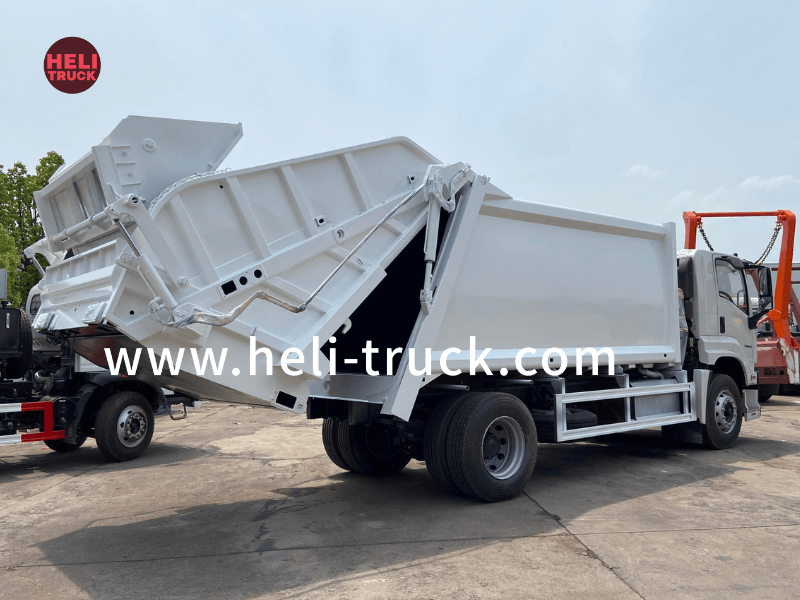Introduction:
Garbage compactor trucks play a vital role in waste management systems around the world. These specialized vehicles are designed to collect and transport various types of waste materials, compacting them to maximize the truck's capacity. Understanding the capacity of garbage compactor trucks is essential for ensuring efficient waste collection and disposal processes. In this article, we will delve into the intricacies of garbage compactor truck capacity, exploring the factors that influence it and the importance of optimizing this aspect of waste management operations.
1. The Basics of Garbage Compactor Trucks:
Garbage compactor trucks, also known as refuse trucks or waste collection vehicles, are specifically designed to collect and transport solid waste from residential, commercial, and industrial areas. These vehicles come in various sizes and configurations, with the most common types being rear-loading, front-loading, and side-loading compactor trucks. Regardless of their design, the primary function of garbage compactor trucks is to compress waste materials to maximize the truck's carrying capacity and minimize the number of trips required for waste collection.
2. Understanding Garbage Compactor Truck Capacity:
Garbage compactor truck capacity refers to the volume of waste that the vehicle can hold and transport in a single trip. This capacity is influenced by several factors, including the size and design of the truck, the type of compaction mechanism used, and the density of the waste being collected. The capacity of a garbage compactor truck is typically measured in cubic yards or cubic meters, with larger trucks capable of holding more waste than smaller ones.
3. Factors Influencing Garbage Compactor Truck Capacity:
3.1 Truck Size and Design:
The size and design of a garbage compactor truck play a significant role in determining its capacity. Larger trucks with higher sidewalls and wider loading bays can accommodate more waste, allowing for greater efficiency in waste collection. Additionally, the design of the compaction mechanism, whether it is a blade, auger, or paddle system, can also impact the truck's capacity by affecting the level of compaction achieved.
3.2 Type of Waste:
The type of waste being collected is another critical factor that influences garbage compactor truck capacity. Different types of waste, such as household garbage, recyclables, construction debris, and green waste, vary in density and compressibility. Heavier and denser materials will require more compaction to maximize the truck's capacity, while lighter materials may not need as much compression.
3.3 Compaction Ratio:
The compaction ratio of a garbage compactor truck refers to the degree to which waste materials are compressed inside the vehicle. A higher compaction ratio results in more waste being packed into the truck, increasing its effective capacity. The compaction ratio is influenced by factors such as the power and efficiency of the compaction mechanism, the type of waste being compacted, and the operating practices of the waste collection crew.
4. Importance of Optimizing Garbage Compactor Truck Capacity:
Optimizing the capacity of garbage compactor trucks is essential for improving the efficiency and effectiveness of waste management operations. By maximizing the amount of waste that can be collected and transported in a single trip, organizations can reduce the number of trips required, lower fuel consumption and maintenance costs, and minimize the environmental impact of waste collection activities. Additionally, optimizing truck capacity helps to streamline waste collection routes, reduce congestion in urban areas, and enhance overall service quality for residents and businesses.
5. Strategies for Maximizing Garbage Compactor Truck Capacity:
5.1 Regular Maintenance and Inspection:
Ensuring that garbage compactor trucks are well-maintained and in good working condition is crucial for maximizing their capacity. Regular maintenance checks, including inspection of the compaction mechanism, hydraulic system, and storage compartments, can help identify and address any issues that may affect the truck's performance. Proper lubrication, cleaning, and adjustment of components are also essential for optimal operation.
5.2 Efficient Loading Practices:
Training waste collection crews in efficient loading practices can help maximize the capacity of garbage compactor trucks. Properly positioning and compacting waste materials inside the truck, avoiding overloading or uneven distribution, and utilizing the full volume of the storage compartment are key strategies for increasing the amount of waste that can be transported in a single trip. Crew members should be trained to operate the compaction mechanism effectively and safely to achieve the desired level of compaction.
5.3 Monitoring and Reporting:

Implementing a system for monitoring and reporting garbage compactor truck capacity can help organizations track performance metrics, identify areas for improvement, and make informed decisions about resource allocation. Using telematics technology, onboard sensors, and software applications, managers can collect data on the volume of waste collected, the level of compaction achieved, and the efficiency of waste collection routes. This information can be used to optimize truck capacity, improve route planning, and enhance overall operational efficiency.
6. Conclusion:
Garbage compactor truck capacity is a critical aspect of waste management operations that significantly impacts the efficiency and effectiveness of waste collection and disposal processes. By understanding the factors that influence truck capacity and implementing strategies to maximize it, organizations can reduce costs, minimize environmental impact, and enhance service quality for communities. Optimizing garbage compactor truck capacity requires a combination of proper maintenance, efficient loading practices, and monitoring and reporting mechanisms to ensure that waste collection operations run smoothly and effectively. As waste management continues to be a pressing issue globally, maximizing the capacity of garbage compactor trucks will play a key role in achieving sustainable and efficient waste management practices.
